ABOUT ME
I am a postdoctoral researcher in atmospheric sciences with expertise in numerical modeling, high-performance computing (HPC) simulations, and statistical analysis. My research focuses on cloud microphysics, extreme weather modeling, and atmospheric simulations, with extensive experience in developing and validating atmospheric models. I have collaborated closely with the Met Office and NOAA, contributing to improvements in cloud process representation within numerical weather prediction models.
In my current role at The University of Manchester, I participate in the NERC-funded project entitled Deep Convective Microphysics EXperiment (DCMEX). My primary responsibility is to determine the optimal representation of secondary ice production and to modify the microphysics parametrisation in numerical weather and climate models. This work is crucial for enhancing the accuracy of heavy precipitation and severe weather forecasts, with broad societal and economic benefits, including improved flash flood prediction, reduced risk for the insurance sector, and greater public safety—potentially even saving lives during extreme events.
Before joining Manchester, my research focused on mesoscale convective systems, particularly thunderstorm and lightning-related hazards. I conducted a lightning field campaign and used the WRF model to investigate the interactions between microphysical and dynamical processes in severe thunderstorms. I also collaborated with NOAA scientists to improve lightning hazard prediction through HPC simulations and statistical analysis. I obtained a Ph.D. in Atmospheric Physics and Environment from the University of Chinese Academy of Sciences, where I studied the impacts of aerosols on thunderstorm electrification using a combination of model simulations and observational data analysis.


Severe Convective Storm
My lightning research combines numerical modeling and observational analysis to evaluate lightning risk in severe convective storms. Using the WRF model, I investigate the microphysical and dynamical drivers of lightning intensity, polarity, and spatial distribution, providing a basis for assessing lightning hazard potential across diverse storm environments.

Extreme Precipitation
My research on extreme precipitation focuses on improving the representation of ice processes in weather models. I work on modifying microphysics schemes, particularly through the integration of secondary ice production, to improve model performance in simulating heavy rainfall. HPC simulations and multi-source validation are used to examine precipitation structure and distribution, with the aim of better understanding storm-driven flood risks.
© Christian - stock.adobe.com 2022
PROFESSIONAL EXPERIENCES & EDUCATION
2023Sep-present
Postdoc
The University of Manchester
Manchester, United Kingdom
In collaboration with Prof. Paul Connolly
Participating in the project "Deep Convective Microphysics EXperiment (DCMEX)" to improve the representation of secondary ice production and modify cloud microphysics scheme in the Unified Model, aiming to enhance the accuracy of heavy precipitation and severe weather forecasts.
2022Sep-2023Aug
Postdoc
The Hong Kong Polytechnic University
Kowloon, Hong Kong
In collaboration with Prof. Zhanqing Li (University of Maryland)
Participated in the project “Comparative Study of Thunderstorms using Numerical Models” to investigate the microphysical and dynamical mechanisms of lightning activity.
Collaborated with NOAA scientists on model-based lightning hazard prediction, integrating numerical simulations with statistical analysis to improve forecast accuracy.
2016-2022
Ph.D., Atmospheric Physics and Environment
University of Chinese Academy of Sciences
Beijing, China
Supervisor: Prof. Xiushu Qie
Co-supervisor: Dr. Edward Mansell (NOAA)
Thesis title: "Impacts and Mechanism of Aerosols on the Electrification and Lightning Discharges in Severe Thunderstorms"
Participated in the project “Dynamic-microphysical-electrical Processes in Severe Thunderstorms and Lightning Hazards" to investigate aerosol-induced changes in storm electrification using the WRF-ELEC model and multi-source observational data.
Conducted model development, sensitivity experiments, and statistical analysis to understand dynamic-microphysical-electrical interactions, focusing on severe thunderstorms over East Asia. (see more in PHD PROJECTS)
2020-2022
Visiting Ph.D. student, Atmospheric Sciences
University of Oklahoma
Norman, U.S.
Co-supervisor: Dr. Edward Mansell
Involved in the development of the numerical WRF model, primarily in microphysics and electrification, and 3D branched lightning parameterization.
PUBLICATIONS
Submitted, accepted, or in press
Sun, M., Connolly, P. J., Field, P. R., Finney, D. L., and Blyth, A. M.: Influence of secondary ice formation on tropical deep convective clouds simulated by the Unified Model, EGUsphere [preprint], https://doi.org/10.5194/egusphere-2025-3158, 2025.
Sun, M., Connolly, P. J., Field, P. R., Finney, D. L., and Blyth, A. M.: Secondary ice production affects tropical convective clouds under different aerosol conditions, EGUsphere [preprint], https://doi.org/10.5194/egusphere-2025-5665, 2025.
Published
Sun, M., Liu, D., Qie, X., Mansell, E. R., et al. 2021: Aerosol effects on electrification and lightning discharges in a multicell thunderstorm simulated by the WRF-ELEC model, Atmos. Chem. Phys., 21, 14141–14158, https://doi.org/10.5194/acp-21-14141-2021
Sun M., Qie X., Mansell E. R., Liu D., et al. 2023: Modeling aerosol impacts on storm electrification and lightning discharges in different environments. Journal of Geophysical Research: Atmospheres, 128, e2022JD037450, https://doi.org/10.1029/2022JD037450
Sun M., Li Z., Wang T., Mansell E. R., et al. 2024: Understanding the effects of aerosols on electrification and lightning polarity in an idealized supercell thunderstorm via model emulation. Journal of Geophysical Research: Atmospheres, 129, e2023JD039251, https://doi.org/10.1029/2023JD039251
Sun M., Qie X., Liu D., Yoav Y., et al. 2020: Analysis of potential effects of aerosol on lightning activity in Beijing metropolitan region. Chinese Journal of Geophysics, 63(5): 1766–1774, https://doi.org/10.6038/cjg2020N0095
Sun M., Qie X., Sun L., Liu D., et al. 2020: Lightning activity of a severe thunderstorm with several hail-fall stages in Beijing metropolitan region. Chinese Journal of Atmospheric Sciences, 44(3): 601–610, https://doi.org/10.3878/j.issn.1006-9895.1910.19134
Liu D., Sun M., Su D., et al. 2021: A five-year climatological lightning characteristics of linear mesoscale convective systems over North China. Atmospheric Research, 256: 105580, https://doi.org/10.1016/j.atmosres.2021.105580
Qie X., Yuan S., Chen Z., Wang D., Liu D., Sun M., et al. 2021: Understanding the dynamical-microphysical-electrical processes associated with severe thunderstorms over the Beijing metropolitan region. Science China Earth Sciences, 64(1): 10–26, https://doi.org/10.1007/s11430-020-9656-8
Li J., Wu X., Yang J., Jiang R., Yuan T., Lu J., Sun M., 2020: Lightning activity and its association with surface thermodynamics over the Tibetan Plateau. Atmospheric Research, 245: 105118, https://doi.org/10.1016/j.atmosres.2020.105118
Finney, D. L., Blyth, A. M., Field, P. R., Daily, M. I., Murray, B. J., Sun, M., Connolly, P. J., Cui, Z., and Böing, S., 2025: Microphysical fingerprints in anvil cloud albedo, Atmos. Chem. Phys., 25, 10907–10929, https://doi.org/10.5194/acp-25-10907-2025
Lu J., Qie X., Xiao X., Jiang R., Mansell E. R., Fierro A. O., Liu D., Chen Z., Yuan S., Sun M., et al. 2022: Effects of convective mergers on the evolution of microphysical and electrical activity in a severe squall line simulated by WRF coupled with explicit electrification scheme. Journal of Geophysical Research: Atmospheres, 127, e2021JD036398, https://doi.org/10.1029/2021JD036398
Dovgalyuk, Y.A., Veremei, N.E., Sinkevich, A.A., Mikhailovskii, Y. P., Toropova, M. L., Yang, J., Sun, M., 2022: Effects of High Aerosol Air Pollution on the Evolution of Convective Clouds during a Thunderstorm in China According to Three-dimensional Numerical Simulations. Russ. Meteorol. Hydrol., 47, 197–206, https://doi.org/10.3103/S1068373922030050
PHD PROJECTS
My Ph.D. studies on aerosol impacts on lightning activity are composed of four parts:
1. Storm structure sensitivity to aerosol-modulated environments
Using the WRF-ELEC model, I investigated how different aerosol concentrations influence convective storm structure and organization.
Key findings:
-
Simulations show larger amounts of graupel, cloud water, and ice under polluted conditions. This indicates more active microphysical growth, especially in the mixed-phase region, where enhanced latent heat release intensifies storm dynamics (Fig.1).
-
Radar reflectivity fields reveal that polluted storms have stronger and deeper updrafts, with echo tops extending to higher altitudes. This reflects enhanced convective strength and more vertically developed storm structures (Fig. 2).
-
Polluted scenarios show a significantly larger storm volume with radar reflectivity exceeding 55 dBZ. This indicates stronger convective cores and broader spatial extent of intense precipitation, reflecting more organized and vigorous storm systems under high aerosol conditions (Fig. 3).
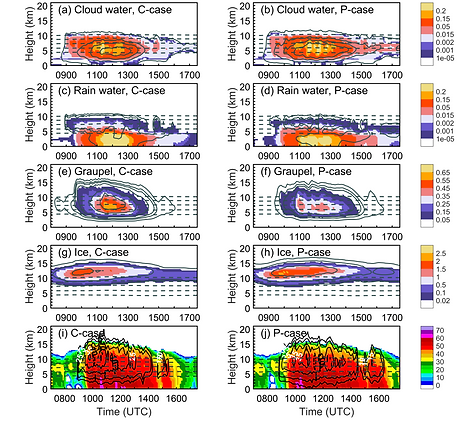
Figure 1. (a)-(h) Temporal variation of the vertical profiles of domain-averaged mass mixing ratio (g kg-1, shaded) and number concentration (kg-1, solid lines) of (a) cloud water in the C-case, (b) cloud water in P-case, (c) rain water in the C-case, (d) rain water in the P-case, (e) graupel in the C-case, (f) graupel in the P-case, (g) ice in the C-case, (h) ice in the P-case. (i)-(j) Time-height maximum simulated radar reflectivity (color shading, unit: dBZ) and maximum vertical velocities (solid line and white label: 10, 15, 25, 35, 45 m/s; dashed line and black label: -10, -15 m/s). The 0 ℃, -10 ℃, -20 ℃, -30 ℃ and -40 ℃ isotherms are shown by the dashed gray lines.
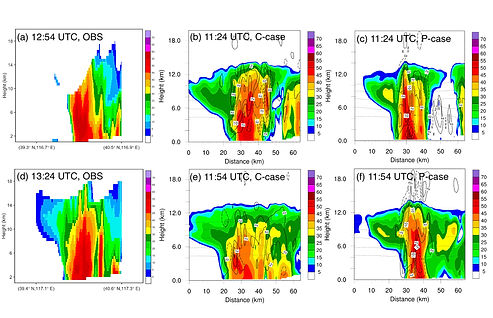
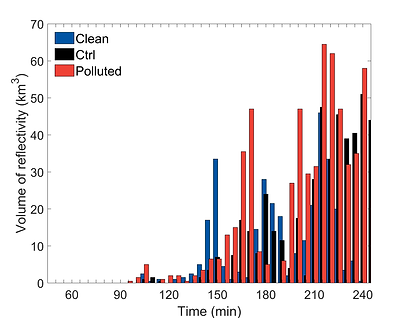
Figure 2. Comparison of vertical cross-section of radar reflectivity (unit: dBZ) between observation and simulations. (a) Observation, (b) Clean (C-case), (c) Polluted (P-case), (d) Observation, (e) C-case, and (f) P-case.
Figure 3. Time evolution of volume of radar reflectivity (km3) greater than 55 dBZ for different cases. The blue, black, and red bars represent clean, Ctrl, and polluted cases, respectively.
2. Numerical modeling of precipitation process under aerosol influence
To explore how aerosol loading affects convective precipitation, I conducted WRF-ELEC simulations of a severe thunderstorm over eastern China on 11 July 2017. The synoptic conditions were characterized by a deep trough over northern China and strong low-level southwesterly flow, transporting warm and moist air into the region—creating favorable large-scale dynamics for this study (Fig. 5).
Results show that aerosol loading alters rainfall intensity, spatial distribution, and precipitation evolution under both real and idealized conditions.
Key findings:
-
Simulations show that polluted cases produce higher peak rainfall rates (up to 97.3 mm/h) and longer-lasting precipitation compared to clean conditions. These results linked to enhanced latent heat release and sustained updrafts (Fig. 4a).
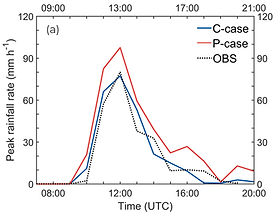
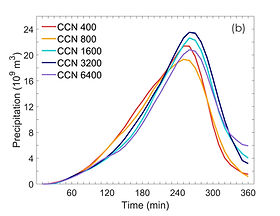
Figure 4. (a) Temporal evolution of the peak rainfall rate for observation and simulations. The dashed black line represents the observation; the red line corresponds to the P case, and the blue line corresponds to the C case. The x axis above is for the observation; the x axis below is for the simulations. (b) Temporal evolution of volumetric precipitation (10^9 m 3) with different cloud condensation nuclei (CCN) concentrations: 400, 800, 1,600, 3,200, and 6,400 cm −3.
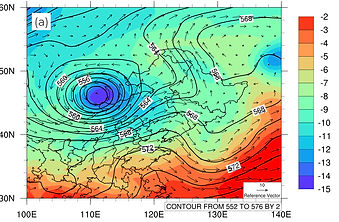

Figure 5. (a) 500 hPa geopotential height (black lines, units: gpm) and temperature (shaded, ℃), (b) 850 hPa geopotential height (black lines, gpm), specific humidity (shaded, units: g/kg) and wind vectors (arrows, m/s) at 06:00UTC on Jul 11, 2017
-
The 6-hourly accumulated precipitation in the polluted scenario aligns more closely with observations, especially in the southeastern region. The polluted case also shows broader spatial coverage of heavy rainfall, highlighting aerosol impacts on storm-scale rainfall distribution (Fig. 6).
-
Idealized simulations show that total precipitation volume first increases and then decreases with rising aerosol concentrations. Under high CAPE conditions, excessive aerosol loading suppresses warm-rain processes, leading to reduced precipitation efficiency and a shift toward delayed or elevated cloud development (Fig. 4b).
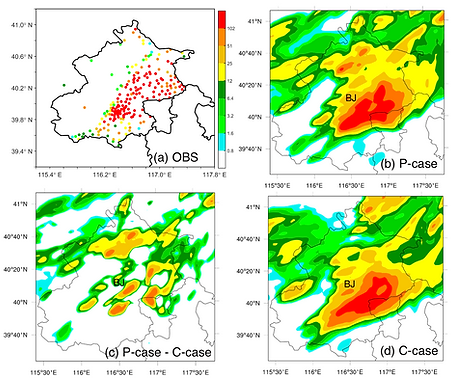
Figure 6. Comparison of accumulated precipitation (units: mm) between observation and simulations. (a) Observation. (b) P case and (d) C case. And (c) difference in accumulated precipitation (units: mm) between the P and C cases.
3. Lightning polarity and intensity shifts in supercell storm simulations
In this part, WRF-ELEC simulations were used to investigate how aerosol loading influences the lightning structure and intensity in multicell and supercell storms. Results show that polluted environments not only increase lightning frequency, but also reorganize the charge structure and polarity, especially enhancing the occurrence of positive cloud-to-ground (+CG) discharges.
Key findings:
-
Polluted cases produce ~50% more lightning flashes compared to clean scenarios, with simulated lightning activity more closely matching observed trends during the storm’s mature stage (Fig. 7).
-
Under high aerosol loading, the charge structure transitions from a conventional dipole to a stronger, elevated tripole configuration with intensified positive charge centers at higher altitudes—supporting more vigorous and frequent lightning discharges (Fig. 8).
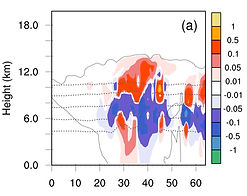
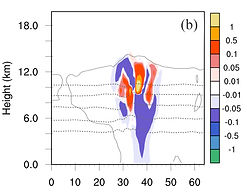
Figure 8. Vertical cross sections of simulated total net space charge (nC m-3, shaded) at the mature stage of the thunderstorm in the (a) C case, and (b) P case. The 0, 10, 20, 30 and 40 ℃ isotherms are shown by dashed lines. The cloud outline (reflectivity echoes 5 dBZ) is denoted by the gray contour.
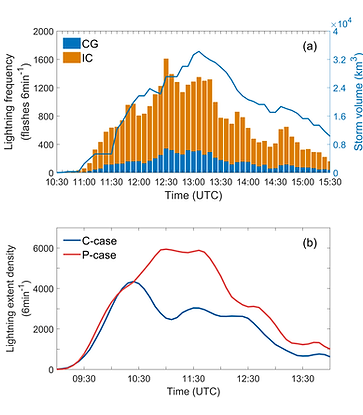
Figure 7. Temporal variation in (a) observed total lightning frequency and (b) simulated flash extent density (FED). In (a), orange represents IC lightning and blue represents CG lightning. The solid line represents the storm volume with radar reflectivity exceeding 30 dBZ. In (b), the red line represents the P case and the blue line represents the C case.
-
In the clean atmosphere (left), there are lower charge density and fewer lightning discharges as a result of less ice-phase particle content. Negatively charged graupel particles at lower supercooled cloud water content (CWC) form a dipole charge structure, leading to discharges dominated by negative polarity. Added aerosols (right) increase the cloud droplet number that can be lifted above the freezing level, leading to higher supercooled CWC. The increased ice particle content and graupel size enhance charge separation, yielding more lightning discharges. Positively charged graupel particles at higher supercooled CWC generate a strong positive-charge region in the middle level, so an inverted-polarity charge structure appears (Fig. 9).
-
Lightning channels originating from this positive-charge region propagate to the ground, producing more +CG strokes. Note that the positive (and negative) lightning shown in the figure is mainly to distinguish the differences between the clean and polluted conditions and does not represent all types of lightning (Fig. 9).
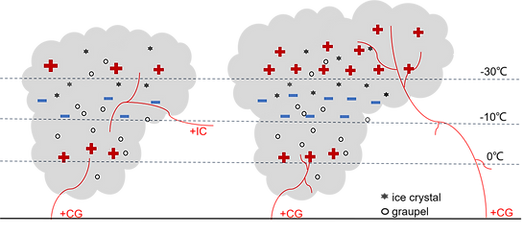
Figure 9. Schematic illustration of the aerosol effects on electrification and lightning polarity.
4. Quantitative analysis of lightning response using multi-source data
In Preparation
Key findings:
-
A lightning jump—defined by a rapid increase in total lightning rate exceeding 2σ threshold—was detected 8 to 18 minutes ahead of three hailfall events, demonstrating its potential as a short-term indicator of severe convection (Fig. 10).
-
Bootstrapped correlation analysis shows that lightning density (FED) is most strongly associated with updraft volume above 5 m/s and 10 m/s (R > 0.95), indicating that vertical velocity is a robust proxy for lightning activity under polluted conditions (Fig.11).
-
In further analysis, FED maintains high correlations with both microphysical (e.g., graupel mass, R = 0.90) and dynamical variables (e.g., w10vol, R = 0.96), confirming that lightning response is jointly governed by storm dynamics and ice-phase processes (Fig. 12).
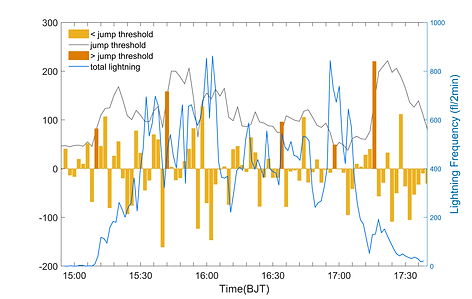
Figure 10. Total lightning frequency (right y-axis, blue line, units: flashes/2 min), change rate of total lightning frequency (left y-axis, bars, units: flashes/(2 min)2), and jump threshold (left y-axis, black line, units: flashes/(2 min)2) during the hailstorm generated in BJ region on 10 June 2016.
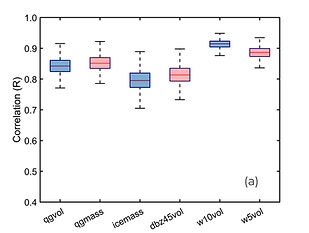
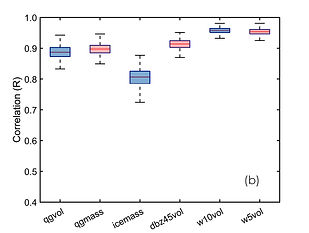
Proxy Variables for Lightning Activity (FED):
Microphysical Variables:
-
Graupel mass (qgmass)
-
Graupel volume exceeding 0.5 g kg-1 (qgvol)
-
Cloud ice mass (icemass)
Dynamical Variables:
-
Vertical velocity volume > 5 m/s (w5vol)
-
Vertical velocity volume > 10 m/s (w10vol)
-
Radar reflectivity volume > 45 dBZ (dbz45vol)
Figure 11. Boxplots of 1000-sample bootstrapped Pearson’s correlations between the time series of FED (unit: 6min -1) and proxy variables listed on the x-axis for the (a) C-case and (b) P-case.
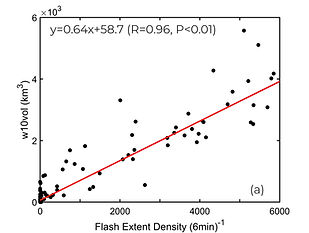
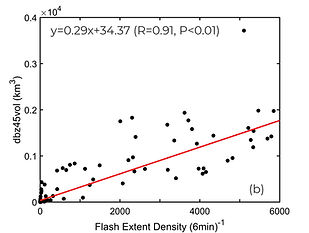
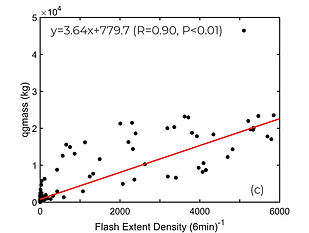
Figure 12. Scatterplots between FED (unit: 6min -1) and proxy variables for the P-case. The coefficients of determination (and R values) for the linear best fit equations shown on the top of each panel. All results are statistically significant at the p = 0.01 level.
This section highlights two complementary approaches to analyzing lightning behavior. First, a lightning jump—a rapid increase in lightning rate—was identified ahead of multiple hailfall events. Separately, correlation analysis was conducted between lightning flash density (FED) and key model-derived variables. These results identify robust microphysical and dynamical proxies, such as graupel mass and strong updraft volume, that help explain variations in lightning intensity.
SKILLS
Numerical Modeling
WRF Model, Unified Model
High-Performance Computing
JASMIN, Monsoon platforms
Conference Presentation
EGU, ICCP, Micro2Macro
Analytics & Model Interpretation
Parameter testing, diagnostics
Scientific Programming
Python, Fortran, MATLAB, SQL
Collaborative Research
Work with Met Office, NOAA



